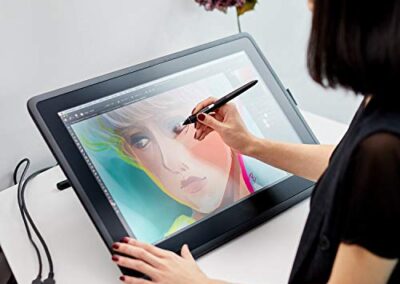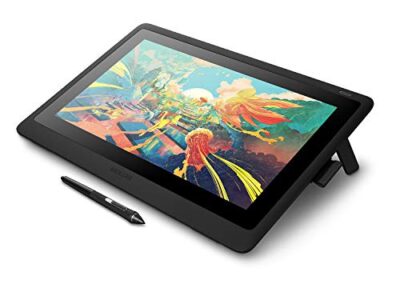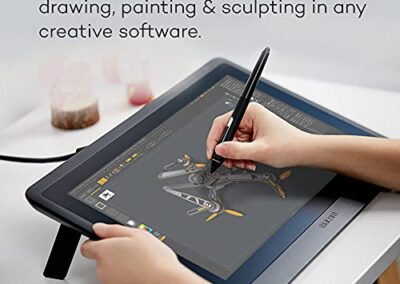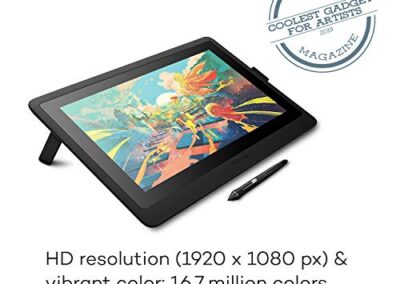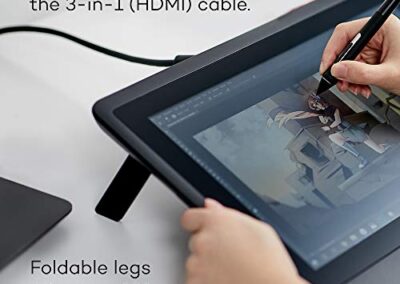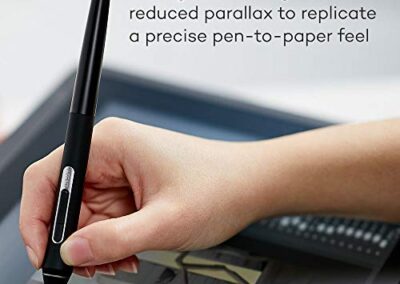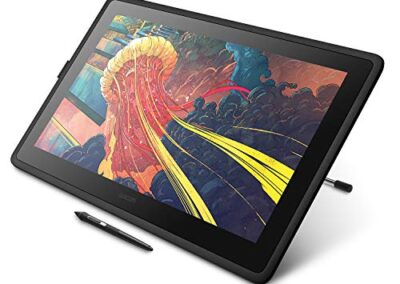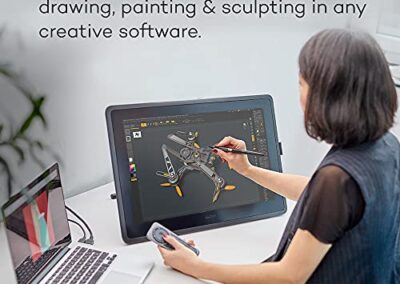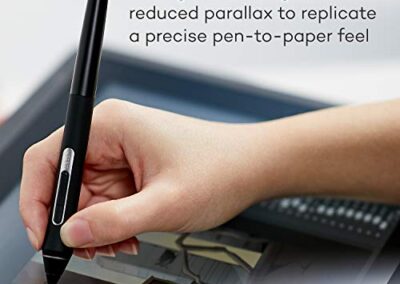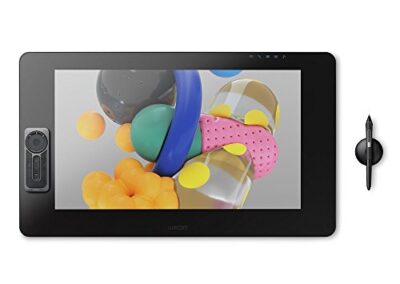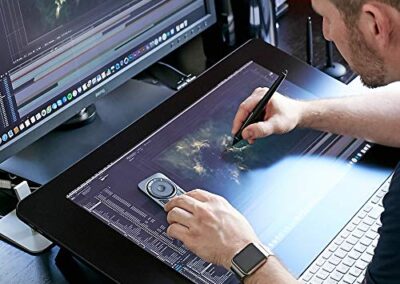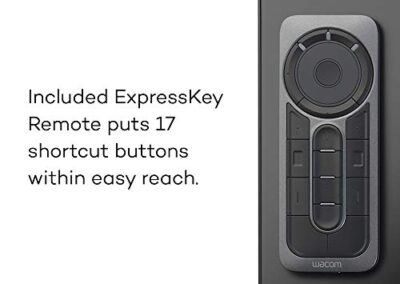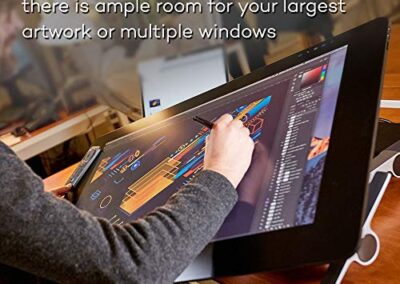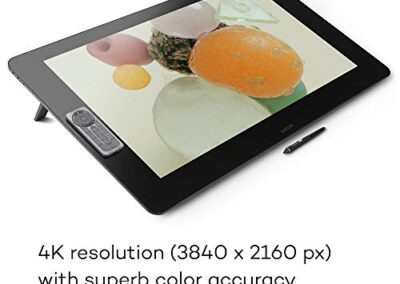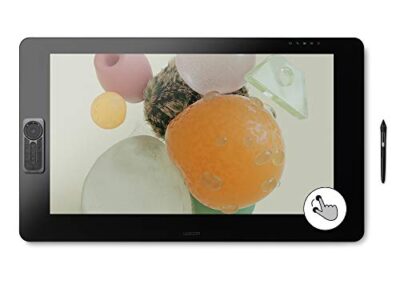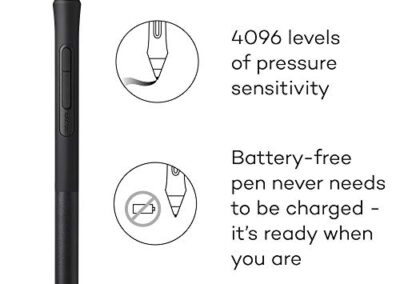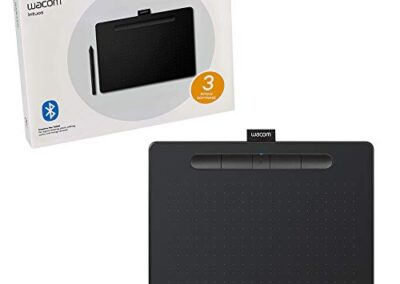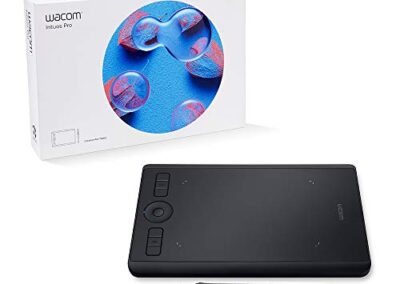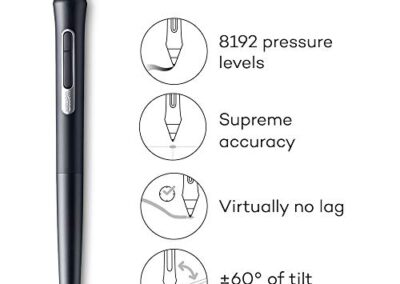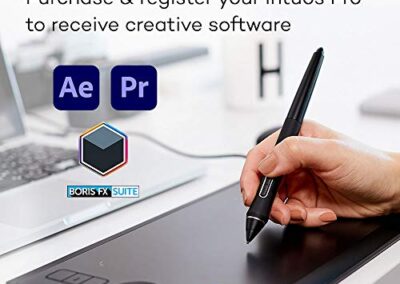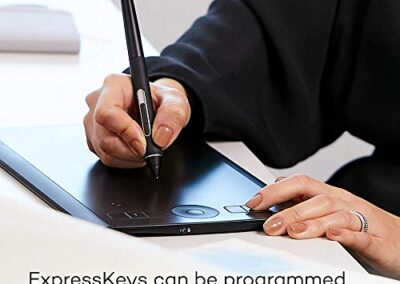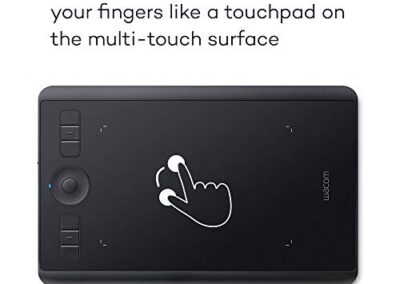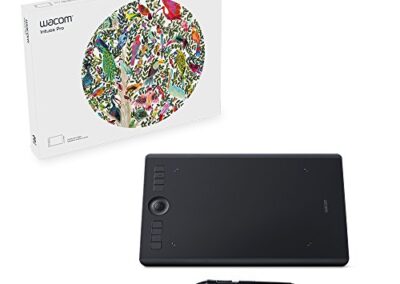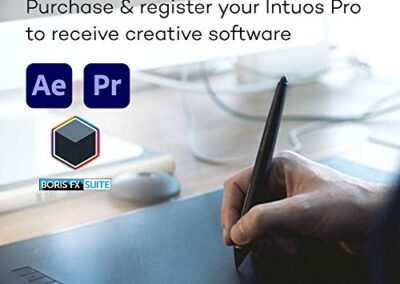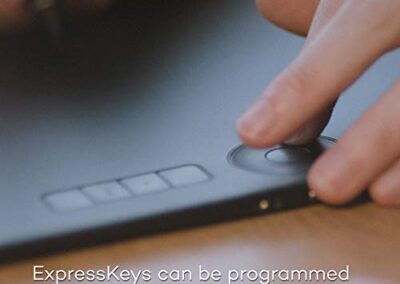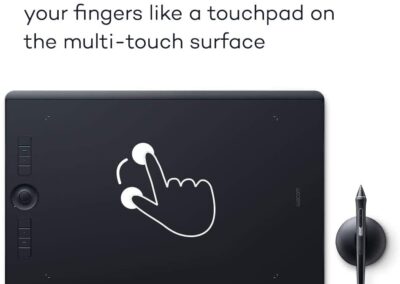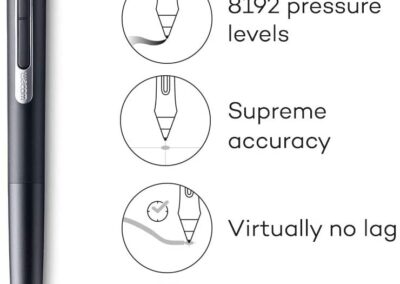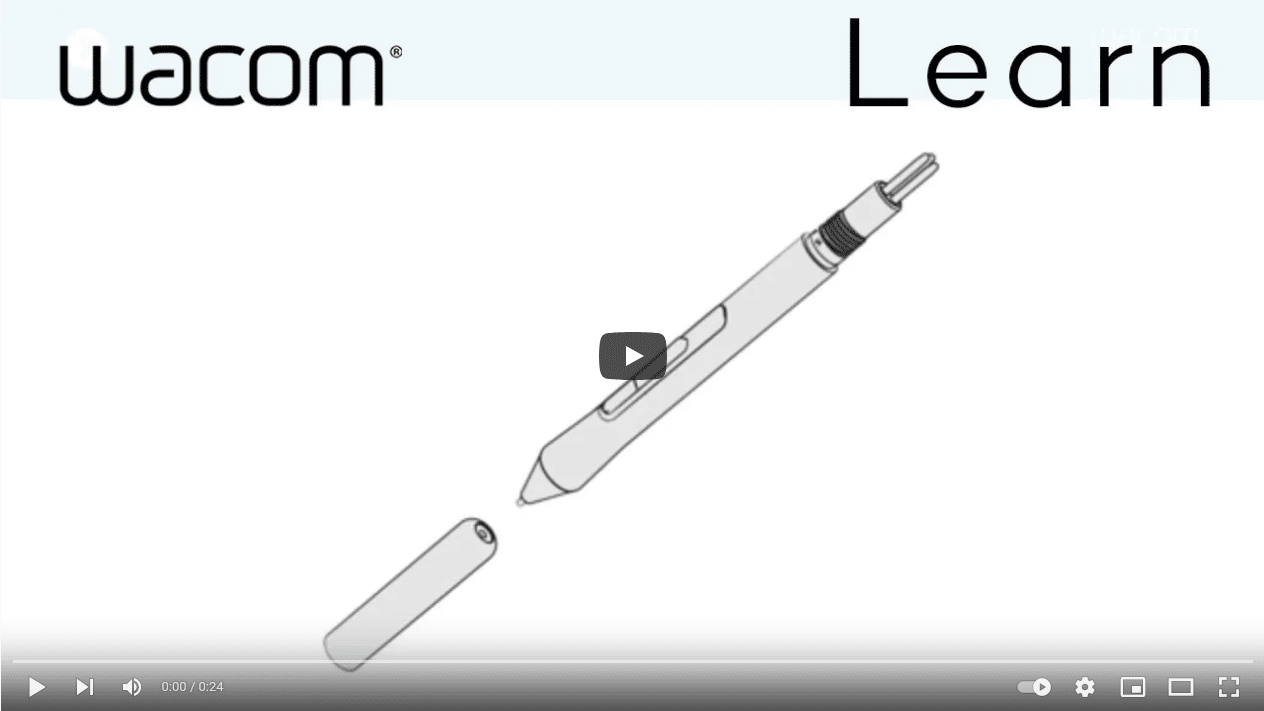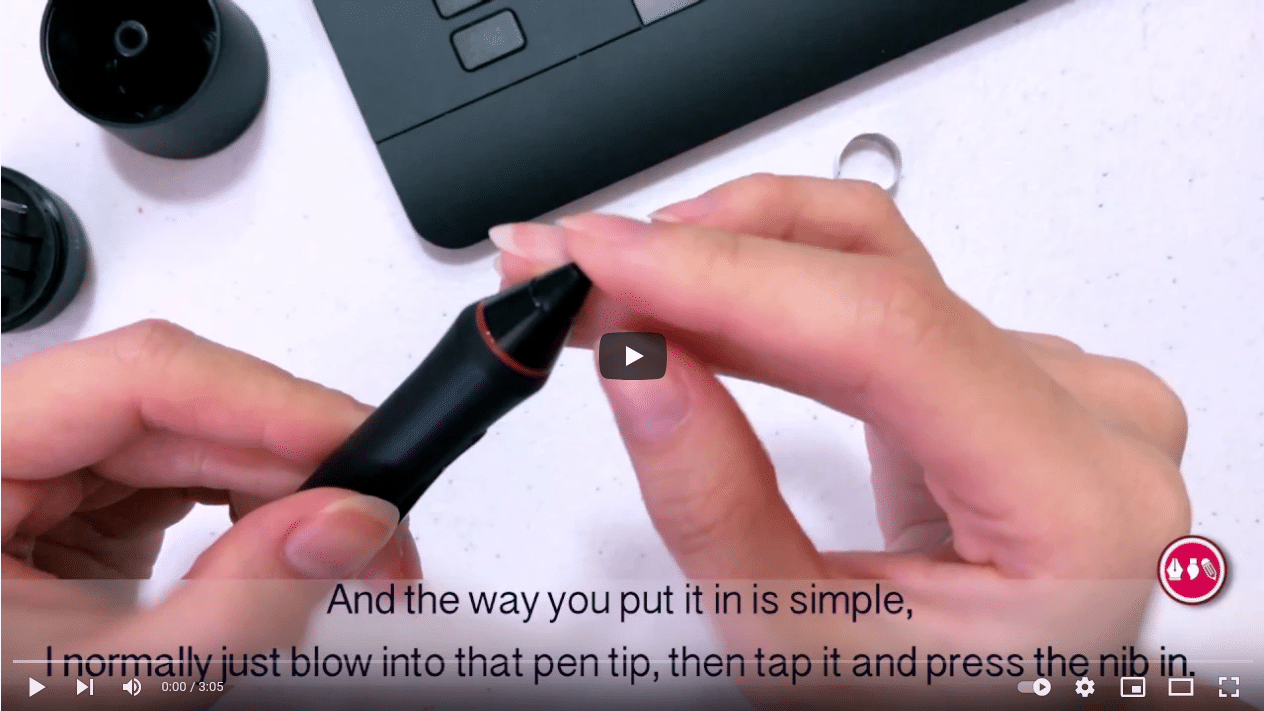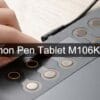Cintiq vs Intuos.
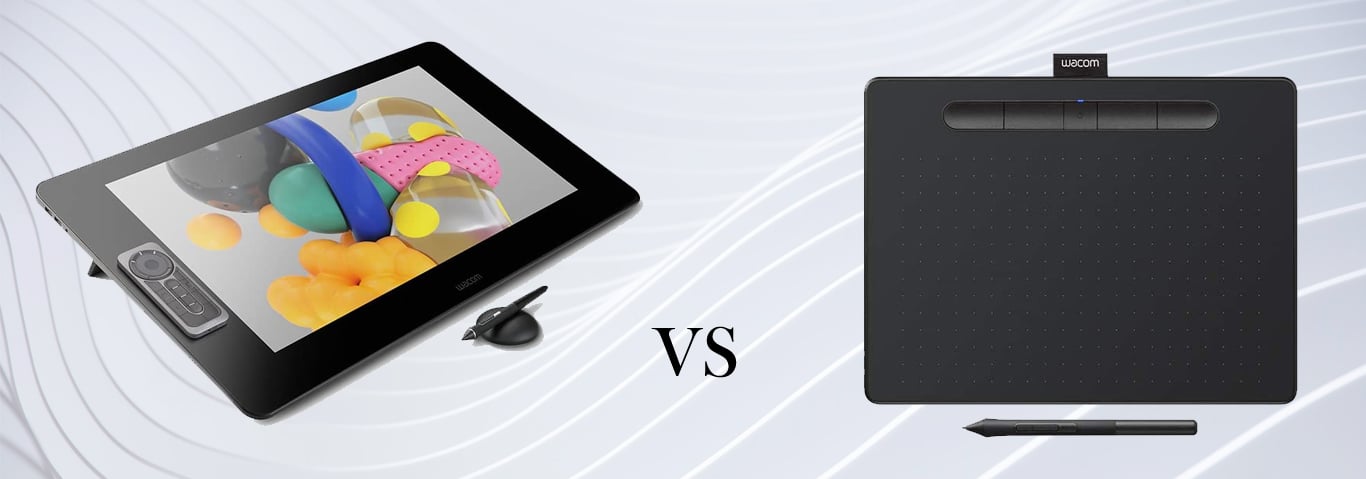
Wacom Cintiq vs Intuos – advice for digital artists and illustrators.
Quick Introduction – My Wacom history.
As a full-time artist and illustrator for over 20 years, as you can imagine I have had quite a few different types of digital pen tablet. Wacom has always been a firm favorite of mine, as they are the world leader in digital pen technology.
My first ever Wacom tablet was the old Graphire3 4×5 model, which I only had for a short period of time before moving onto the Intuos2 6×8. This was an amazing tablet to work with, and at that time it became clear to me how much easier artwork could be with digital tablets.
The Intuos2 was also my first introduction to the idea of pressure sensitivity, and the difference between the pencil tool in Photoshop is night and day compared to working without one. At that time, I mostly worked with Adobe Photoshop 3, Painter5, and Illustrator8 (with the new variable pressure pen). I did not really get round to using any other Wacom tablets after the Intuos2, because it was near perfect for my needs for many years.
Fast-forward to 2021, and here I am with a Wacom Cintiq 32 & the large size Wacom Intuos Pro! I use them differently according to the projects I’m working on.
Up to the current day – I am constantly asked which Wacom tablet to purchase, whether it be a Cintiq or Intuos model. To be honest both are great products that offer different features depending on your needs as an artist.
Cintiq vs Intuos
I always suggest to people that if possible they should try both products for themselves, as I feel it’s the only way you can really get to grips with what features will benefit your work most. It also depends on whether or not you are looking for a drawing tablet or an artist’s tablet – whichever one is best for you?
Let’s get into this in more detail.
Disclaimer – This website contains affiliate links. If you find the information useful and click on a product link and make a purchase, a small commission will be earned by Big Red Illustration
How Do I Decide Which Drawing Tablet to Get?
Ultimately the deciding factors will all revolve around a few key points that are personal to you, the way you work, and the type of work you create. I have been asked hundreds of times the question “how do I decide which tablet to purchase?” – and as always, my answer is that it really depends on a number of different things.
Although both types of digital tablets offer a great solution for artists and illustrators alike, there are still a few key differences between Intuos vs Cintiq.
Here are a few things to consider and things we’ll discuss to narrow down your choice:
- Your budget
Budget will play a massive factor in your choice when it comes to Intuos vs Cintiq. The Intuos tablet range starts at around $70, while the Cintiq starts from the $650 mark.
If you are on a tight budget, no doubt an Intuos would be your preferred choice. Although some of the cheaper tablets may not offer some of the premium features and extras that are available on the Cintiq line of models.
- Size of tablet surface – do you require a small or large drawing area?
Both Cintiq’s and the Intuos ranges come in different sizes. The Cintiq comes in 16″ 22″ 24″ and 32″ sizes, while the Intuos is available in small, medium or large size.
The price starts to differ between each model as you increase the drawing area of the tablet. The more expensive models include additional features such as Express Keys – which can be custom programmed. Some of these models also have multi-touch support.
- Which tablet to use for digital art? Intuos vs Cintiq for specific software
There are a few applications that I know instantly come to mind when thinking about using a Wacom digital drawing tablet, such as Photoshop and Adobe Illustrator.
Both the Wacom Cintiq and Intuos tablets have been designed especially with those software packages, along with other industry leaders in mind.
The Wacom stylus pen has been designed to work perfectly with the most popular digital art software, however, it’s also compatible with many other creative software suites used by artists every day. If using lesser known packages such as clip studio paint, it’s important to check with the software creator first if using a particular software is a key factor in your decision.
- What kind of digital art do you want to use your drawing tablets for?
Although it is true that both the Wacom Cintiq and Wacom Intuos tablets are suitable for most if not all types of digital artwork, there are differences between them that will suit some users more than others.
Difference between Cintiq and Intuos
Discussing Illustration, Graphic Design, Line Drawings, Vector Graphics On-screen drawing experience.
Of course, the main difference between the two models is that the Cintiq range has a screen to draw directly upon. But that much you knew already. How does this affect you as an artist? Well if your main line of digital artwork is line work, finely detailed illustration, vector drawing, or graphic design, then you will no doubt benefit from drawing on the screen of a Wacom Cintiq.
The accuracy is phenomenal and I would highly recommend considering this model over the Intuos range if that is your main focus. Digital illustrators, comic artists, and other creatives whether professional or students will benefit from using a Cintiq.
Painting, Digital Painting, Color-blending – using a stylus with less restriction for creative work.
For those of us who prefer to paint, sketch or color blend digitally on a Wacom tablet surface you would most definitely benefit from an Intuos pro model in conjunction with a separate monitor.
The reason for this is that the stylus pen offers users to sit further away from the screen and gives more freedom than most people would be used to with a Cintiq tablet – therefore they can give you more movement when it comes to color blending and creating brushstrokes in your artwork. The Wacom Intuos pro medium is the most popular, but small and large are also available in the pro range.
Let’s look at the Wacom tablet models:
Wacom Cintiq Range:
Wacom Cintiq 16
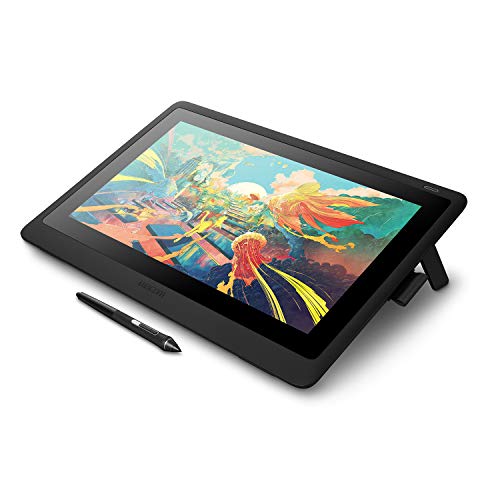
- Screen: 15.6 inch
- Screen resolution: 1920 x 1080 (Full HD)
- Colorgamut: 72% NTSC (CIE1931) typical
- Pen technology: Wacom Pro Pen 2 with Wacom EMR
- Pen pressure levels: 8,192
Wacom Cintiq 22
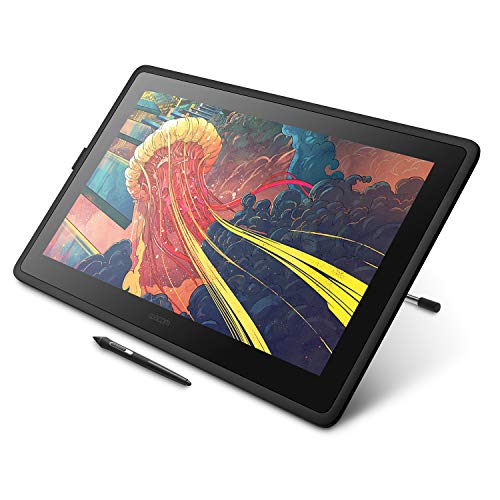
- Screen: 21.5 inch
- Screen resolution: 1920 x 1080 (Full HD)
- Color gamut: 72% NTSC (CIE1931) typical
- Pen technology: Wacom Pro Pen 2 with Wacom EMR
- Pen pressure levels: 8,192
Cintiq Pro Range:
Cintiq Pro 16
- pro model
- Size 410 x 265 x 17.5 mm (16.2 x 10.4 x .7in)
- Weight 1.5 kg (3.3 lbs) without optional stand
- Screen (Measured Diagonally) 39.6 cm / 15.6 in
Cintiq Pro 24
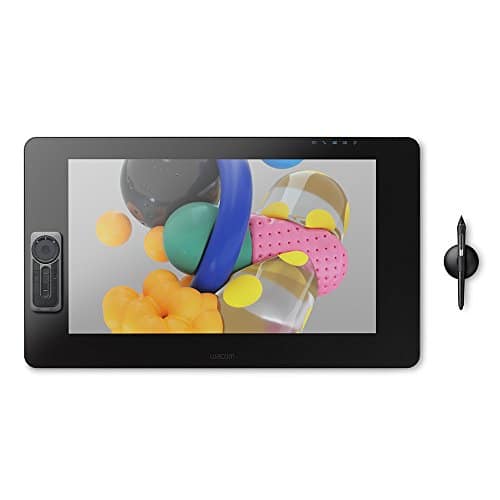
- DTK-2420 creative pen display
- DTH-2420 creative pen display touch
- Display size 677 x 394 x 47 mm (26.65 x 15.5 x 1.9 in)
- Display weight 7.2 kg (15.87 lbs) without optional stand
- Screen Size (Measured Diagonally) 59.94 cm / 23.6 in
Cintiq Pro 32

- Model number DTH-3220 Wacom Cintiq Pro 32 creative pen display touch
- Display size 854 x 506 x 53.25 mm
- (33.62 x 19.92 x 2.1 in)
- Display weight 13 kg (28.66 lbs) without optional stand
- Screen Size (Measured Diagonally) 80 cm / 31.5 in
Wacom Intuos Range:
Size
- Wacom Intuos Small: 200 x 160 x 8.8 mm / 7.87 x 6.3 x 0.35 in
- Wacom Intuos Medium: 264 x 200 x 8.8 mm / 10.4 x 7.8 x 0.35 in
Active area
- Wacom Intuos Small: 152.0 x 95.0 mm (6.0 x 3.7 in)
- Wacom Intuos Medium: 216.0 x 135.0 mm (8.5 x 5.3 in)
Intuos Small:
Intuos Medium:
Wacom Intuos Pro Range:
Sizes
- Wacom Intuos Pro Small: 269 x 170 x 8.45 mm / 10.6 x 6.7 x 0.3 in
- Wacom Intuos Pro Medium: 338 x 219 x 8 mm / 13.2 x 8.5 x 0.3 in
- Wacom Intuos Pro Large: 430 x 287 x 8 mm / 16.8 x 11.2 x 0.3 in
Active area
- Wacom Intuos Pro Small: 160 x 100 mm / 6.3 x 3.9 in
- Wacom Intuos Pro Medium: 224 x 148 mm / 8.7 x 5.8 in
- Wacom Intuos Pro Large: 311 x 216 mm / 12.1 x 8.4 in
Intuos Pro Small:
Intuos Pro Medium:
Intuos Pro Large:
Intuos Pro vs Cintiq –
Which Wacom tablet should I buy?
Why Get The Cintiq? Pros and Cons
Here are the main reasons why you may decide that the Cintiq is the on-screen graphic tablet for you:
Drawing directly on the screen is something that really doesn’t need much explanation – It’s awesome! The Cintiq feels more natural and closer to drawing on canvas or paper.
You can draw more comfortably up close to your screen without straining your eyes or pushing your face toward the monitor.
The larger screen sizes mean that you can work on most types of artwork without zooming or panning
Workflow speed will undoubtedly increase
The quality of your work will improve, they’re simply brilliant for accurate line art (or any work that requires finely detailed drawing).
More advanced features such as the ExpressKeys and Rocker Ring make them easy to customize for fast workflow acceleration.
Cons of using a Cintiq:
Parallax issues – what is parallax? On the older models of the Cintiqs, there is a very slight distance between the pen and the on-screen cursor. It’s not huge and certainly not a deal-breaker for most, however, the newer models have pretty much solved this minor problem anyway.
Some find that the hand covers the artwork as they work on screen
Cost – If you are a busy professional, the Cintiq is a great investment, allowing more work to be completed in a shorter space of time. This increase in workflow speed will ultimately pay for itself over a short time. However, if you are new to digital art or a hobbyist, the cost may be a major con to get around.
Little learning curve involved.
Older models of the Cintiq’s have issues with color accuracy
Large and heavy.
May require extra purchases such as a flex arm or stand in order to get the most comfortable drawing position for you. A more ergonomic position is important when working for long hours at a time.
Why Get the Intuos or Intuos Pro?
The Intuos pro pen tablet is smaller, lighter and tidier than Cintiqs. Perfect if you travel or work in different locations regularly.
They are more affordable, meaning you can get a starter Intuos model for around half the price of the cheapest Cintiq tablet.
The hand does not in any way obstruct the artwork.
The Intuos line work is very similar to the Cintiq.
More robust and less likely to have problems than the Cintiq line. As there is no screen and a lot less in the way of behind-the-scenes tech inside an Intuos, it is less likely to have any functionality or display issues.
Some people naturally prefer having a drawing tablet working independently of the screen, rather than drawing on a screen
Cons of using the Intuos or Wacom Intuos Pro:
It takes practice to draw using a tablet without a screen, the learning curve is a little steeper as drawing onscreen is more natural for most.
The overall spec of the Intuos range is not as high in several areas as the Cintiq.
When speaking with colleagues in the illustration industry, workflow is slightly slower using Intuos than the Cintiq.
Alternatives to the Wacom Cinqtiq and Wacom Intuos / Intuos Pro
If you like the idea of working “on-screen” and are considering a Cintiq, why not take a look at the new Wacom Mobile Studio Pro 13 or Wacom Mobile Studio Pro 16 models!
These work totally independently of a PC or Mac and enable you to work directly on the screen quickly and smoothly. With these, it’s possible to get up and running straight away, without having to install drivers, have connectivity issues for example.
We have reviewed these models in more detail on our page Wacom vs Surface Pro, along with the pros and cons of using a Microsoft surface pro tablet instead of a Wacom.
Conclusion – Which Wacom Tablet, Cintiq vs Intuos?
Wacom drawing tablets have always been admired for their quality, reliability, and ease of use. While there are other drawing tablets available on the market, Wacom remains the leading manufacturer of digital art supplies because of these qualities.
Although I’d love to say with certainty whether you should get an Intuos Pro or Wacom Cintiq, it does come down to individual choice and preference – I would say try both of them out if you can, that’s the best way of finding out!
From a personal point of view, I produce mainly detailed line work, illustrations, and vector graphics. Therefore, if I had to choose only one, I’d 100% go for the Cintiq Pro 32 for everyday studio work. I spend a LOT of time on mine and it’s a joy to use.
I hope that you find the Wacom tablet information above helpful in making your purchase decision.
Thank you for reading!
Wacom Tablets – FAQ’s
- What is pressure sensitivity and why is it important?
Pressure sensitivity is a measure of how much physical pressure is required to make lines and marks on the tablet. This means that as you press harder against the pen nib, thicker and darker lines will be drawn. This replicates as closely as possible using traditional media. In the real world, how you use the pressure sensitivity feature will depend on the art software you are using and your chosen settings.
- Zbrush Cintiq vs Intuos drawing tablet?
Whether using Zbrush, Photoshop, Corel Painter, Illustrator, autodesk sketchbook, or any other digital art Mac / PC software, the key points of this article will still apply. I know of some Zbrush artists that use the Wacom Cintiq and others that swear by the Intuos Pro tablets.
- Is a Wacom Good For Video editing
Yes. A Wacom tablet can improve your video editor skills! Using a tablet increases editing pace, efficiency and ultimately leads to a more time-effective workflow. The accuracy of a Wacom pen over a mouse and the programmable buttons you can assign to different tasks make a Wacom a great choice for professional video editors for sure.
- Are the pens the same on the Wacom Cintiq and the Intuos Pro?
When it comes to Wacom products and in particular the Wacom pens, they are not always compatible from one model to the next. This is due to the evolving technology for the pen input and the way the pens interact with the board or screen. The pen feel tends to be similar across the range and come with side buttons that can be assigned to certain tasks, such as undo, pan, scroll, zoom etc unlike the Apple Pencil / iPad pro for example which doesn’t have this functionality. The newer models of Wacom have a better pen than older versions as it has been updated and improved over time.
- Is the Wacom Cintiq worth it?
Yes. If you spend enough time with one, the Wacom Cintiq will change your life. It’s that simple! The Wacom Cintiq and Intuos Pro both provide a dynamic, immensely satisfying working experience. However, the Cintiq is more expensive than the Intuos series tablets.
- Which is best for Wacom, A Desktop PC or Mac?
The Wacom Cintiq and the Wacom Intuos Pro range work equally well on bot PC and Mac. Which is “best” depends on which you are used to using and the other software applications you run. It’s a bit like saying, “Which is best, a PC or Mac?” a long-debated argument we’re not getting into here 🙂 However, the key thing to consider is the PC or Mac spec – the faster the processor, the better the graphics spec, and the more RAM you have, the better the performance will be.
- Can you change the Wacom pen nib on Intuos and Cintiq models?
Yes. You typically will get a number of spare nibs, and different textured nibs as part of the pack when you make a purchase. Included will be a tool to help you remove one nob to insert another.
Here’s how to change a Wacom nib:
- Can the Cintiq be used as a second monitor?
Yes! The Wacom Cintiq is actually designed to function as an additional monitor. This can be incredibly useful for professional video editing, photo-editing and other graphic design work. People who work with 2 (and more) screens / pen displays will save heaps of time when switching between tasks by having the tablet screen in front of them.
- Which Intuos model is most popular with digital artists?
A recent Facebook poll targeted towards professional artists and illustrators revealed that out of all of the Intuos users in the group, the most popular model/size was the Wacom Intuos pro Medium. This model is essentially the same and shares the same features as the Wacom Intuos Pro smaller and Wacom Intuos Pro larger tablet, but medium-sized.
- Intuos or Cintiq which is best for beginners?
If you are a traditional artist transferring to digital, or just new and interested in starting your digital journey, I would recommend the Wacom Intuos Pro Medium. The Intuos Pro offers pen tablet functionality, at an entry-level price that will not break the bank. The drawing feel will take a bit of practice as you draw on the tablet rather than on the screen.
If price is not an issue, however, you will find that the Wacom Cintiq is easier to use and offers a more traditional drawing feel when creating artwork, as you draw and paint as you would on paper or canvas.
Affiliate Disclosure
In compliance with the FTC guidelines, please assume the following about all links, posts, photos and other material on this website:
Any/all of the links on this website are affiliate links of which The Big Red Illustration Agency receives a small commission from sales of certain items, but the price is the same for you.
www.bigredillustrationagency.com is a participant in the Amazon Services LLC Associates Program, an affiliate advertising program designed to provide a means for sites to earn advertising fees by advertising and linking to Amazon.com & Amazon.co.uk. Pages on this site may include links to Amazon and its affiliate sites on which the owner of this website will make a referral commission.
Cookie preferences: cookie preferences
Written By Adam Rushton
Adam has made a name for himself in the illustration industry and is a passionate blogger and writer on the subject of art, illustration and graphic design.
His artwork has been featured in countless publications and used for very well-known media projects. As a professional illustrator for over 20 years, Adams media outlets, a wealth of knowledge, and experience enable him to consult and advise artists and illustrators in this country (from York and Manchester to Southampton and London) and all over the world.


